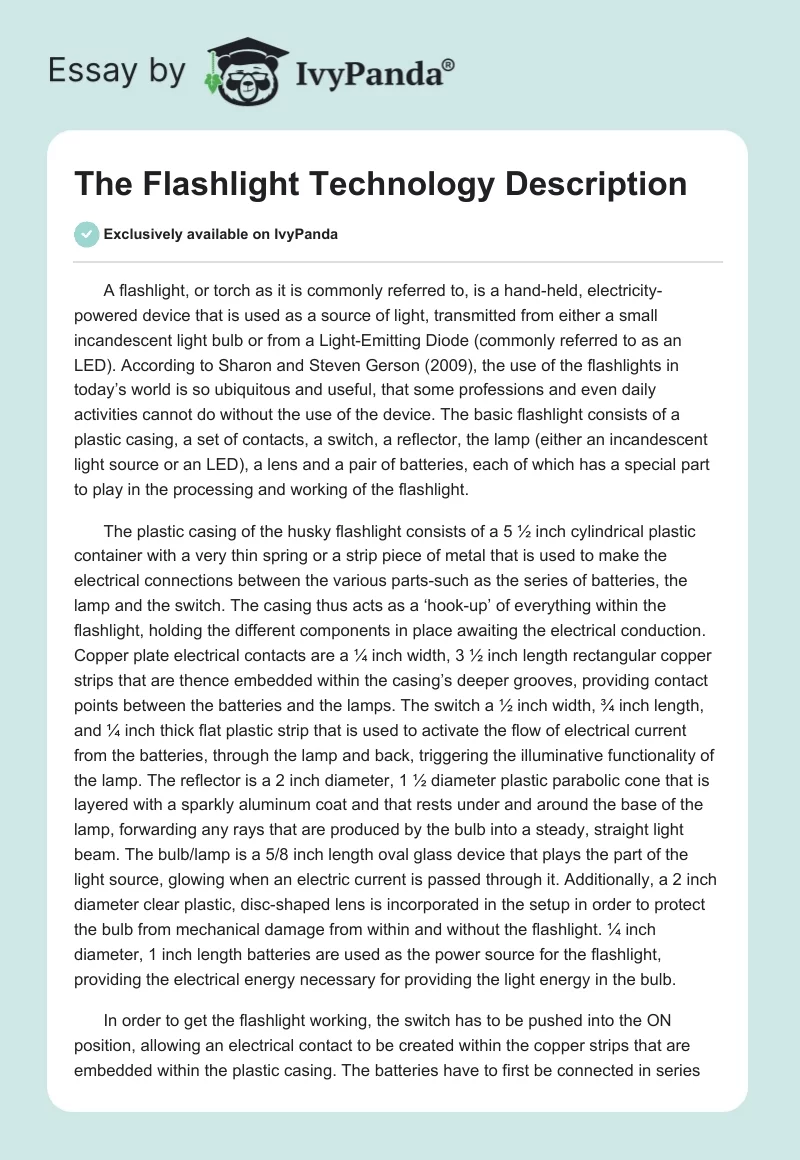A flashlight, or torch as it is commonly referred to, is a hand-held, electricity-powered device that is used as a source of light, transmitted from either a small incandescent light bulb or from a Light-Emitting Diode (commonly referred to as an LED). According to Sharon and Steven Gerson (2009), the use of the flashlights in today’s world is so ubiquitous and useful, that some professions and even daily activities cannot do without the use of the device. The basic flashlight consists of a plastic casing, a set of contacts, a switch, a reflector, the lamp (either an incandescent light source or an LED), a lens and a pair of batteries, each of which has a special part to play in the processing and working of the flashlight.
The plastic casing of the husky flashlight consists of a 5 ½ inch cylindrical plastic container with a very thin spring or a strip piece of metal that is used to make the electrical connections between the various parts-such as the series of batteries, the lamp and the switch. The casing thus acts as a ‘hook-up’ of everything within the flashlight, holding the different components in place awaiting the electrical conduction. Copper plate electrical contacts are a ¼ inch width, 3 ½ inch length rectangular copper strips that are thence embedded within the casing’s deeper grooves, providing contact points between the batteries and the lamps. The switch a ½ inch width, ¾ inch length, and ¼ inch thick flat plastic strip that is used to activate the flow of electrical current from the batteries, through the lamp and back, triggering the illuminative functionality of the lamp. The reflector is a 2 inch diameter, 1 ½ diameter plastic parabolic cone that is layered with a sparkly aluminum coat and that rests under and around the base of the lamp, forwarding any rays that are produced by the bulb into a steady, straight light beam. The bulb/lamp is a 5/8 inch length oval glass device that plays the part of the light source, glowing when an electric current is passed through it. Additionally, a 2 inch diameter clear plastic, disc-shaped lens is incorporated in the setup in order to protect the bulb from mechanical damage from within and without the flashlight. ¼ inch diameter, 1 inch length batteries are used as the power source for the flashlight, providing the electrical energy necessary for providing the light energy in the bulb.
In order to get the flashlight working, the switch has to be pushed into the ON position, allowing an electrical contact to be created within the copper strips that are embedded within the plastic casing. The batteries have to first be connected in series and with their positive and negative terminals in a back-to-back setup, resting on top of a relatively small, ¾ inch diameter, ¾ inch length metallic, spiral spring which is in turn connected to the copper strip connectors. Another set of contact strips is present on the other side of the casing, running all the way, and creating contact with the bulb. This completes the circuit with the lamp, allowing the generated electricity to flow in a continuous loop.
On activation of the switch to the ON position, an electrical current is allowed to flow through the now connected circuitry, making the tungsten filament within the bulb to glow brightly with the production of light that is visible to the naked eye. This light is then reflected through the reflector at the base of the lamp, directing the produced rays into a steady beam. This is emitted through the glass lens, covering and protecting the bulb, illuminating any surfaces that the user wishes to shed light on. When the switch is pushed to the OFF position, the connection between the two copper strips is broken, effectively breaking the flow of the current to the bulb and ending the production of light.
References
Gerson, S.J., and Gerson, S.M. (2009). Technical communication: Process and product. New York, NY: Pearson Education.


